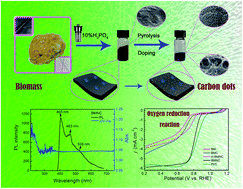An assembly of carbon dots and carbon sheets from plant biomass for excellent oxygen reduction reaction†
Abstract
The activity of electrocatalysts determines the performance of the oxygen reduction reaction, the cathodic reaction of regenerative fuel cells. In this article, an N-doped hierarchical porous assembly of carbon dots and carbon sheets, BMNC, was synthesized using spikes of cattail as raw material via a hydrothermal reaction in dilute phosphoric acid, carbonization at 900 °C, chemical activation and N-doping at 650 °C. Its optical spectra exhibit a strong UV-visible absorption from 200 to 800 nm and fluorescence emission peaks at 404, 463 and 524 nm, showing that a large conjugated system of carbon dots exists in the matrix. BMNC has a high surface area of 2260 m2 g−1 with abundant micropores and possesses lots of carbon defects and three kinds of nitrogen atom: pyridinic, pyrrolic, and graphitic N. BMNC shows high electrocatalytic activity for ORR with a higher stability and better immunity to methanol than 20% Pt/C. The onset and half-wave potential of ORR are 0.81 and 0.73 V vs. RHE in alkaline solution. The characterization of BMNC after reaction in alkaline solution indicates that the carbon defects are active sites for ORR. This assembly provides a reference direction for the preparation of new structural nanocarbon materials as high-efficiency and low-cost electrocatalyst for ORR.



 Please wait while we load your content...
Please wait while we load your content...